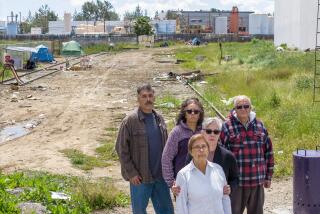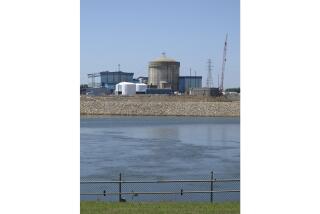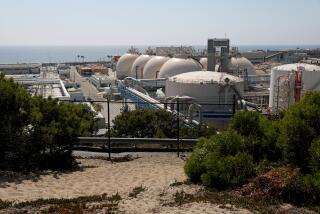Report finds serious defects at Hanford nuclear waste treatment plant
- Share via
A team of nuclear waste experts has found hundreds of serious defects at an Energy Department plant designed to turn millions of gallons of highly radioactive sludge into more stable solid glass at the former weapons facility in Hanford, Wash.
The 2014 report, which was leaked Tuesday, is the latest blow to the massive federal program to prevent radioactive waste at Hanford from contaminating the nearby Columbia River.
The partially built facility is riddled with 362 “significant design vulnerabilities” that could affect safety and future operations, according to the report, which was commissioned by the government.
The team, for example, found that an O-ring designed to seal 1,250-degree gases would fail at 250 degrees. It also found a number of ventilation problems, potentially allowing radioactivity to migrate into safe areas of the plant. The experts warned that the plant’s design would increase the difficulty of decontamination, if it ever became necessary.
The report was written by 37 experts, led by two senior managers at the site and top chemical and nuclear engineers from across the nation.
The experts concluded that the “future plant performance and production are not reliable,” raising concerns about the ability of completing the waste treatment in four decades, as planned.
The findings are significant because the plant is part of the Energy Department’s 2013 initiative to fix earlier problems that stalled construction of other parts of the treatment system at Hanford, the site of the nation’s worst radioactive contamination.
Indeed, the report of major design flaws echoes the same kinds of problems that have dogged the nuclear waste cleanup program for more than two decades, raising more concerns that the Energy Department may not be able to control the waste and convert it to a form that can be safely stored for tens of thousands of years.
“It is jaw-dropping,” said Tom Carpenter, executive director of the watchdog group Hanford Challenge, which obtained the confidential report and released it Tuesday. “I don’t understand how the system could have failed us so badly.”
Federal officials disputed the importance of the report and said it was a “very early draft that contained a number of factual inaccuracies.” The statement, issued by the Energy Department’s Office of River Protection, said the report “does not identify any unknown major technical issues” with the treatment plant.
“The department is committed to designing, building and safely operating the waste treatment and immobilization plant,” the statement said.
San Francisco-based Bechtel Corp., which is managing the project, issued a statement saying the report contained factual inaccuracies, though it did not identify them.
It added that only 5% of the comments in the review were new and that they were already being addressed.
“We will continue identifying and addressing concerns as we work with DOE to ensure we complete a Waste Treatment Plant that will safely and efficiently treat the Hanford tank waste,” Bechtel said.
Nuclear waste has leaked from a third of the 177 underground tanks, which contain 56 million gallons of waste products from the chemical refinement of plutonium, dating back to the World War II-era Manhattan Project. The last reactor was shut down in 1988.
The waste is so radioactive that even a momentary exposure would be lethal.
Treating the waste has proved to be a vexing engineering challenge, a financial drain on the federal budget and a sore point with Washington state officials who are pressing for faster action on the project.
In 2006, construction of several of the Hanford facilities was stopped when engineers discovered they had miscalculated the risks of an earthquake and would have to retrofit equipment to withstand greater forces.
In 2013, then-Energy Secretary Steven Chu stopped most construction again when a research chief at the facility found it had flaws that could cause an explosion.
In an effort to treat the waste quickly, Chu’s successor, Ernest J. Moniz, ordered that some of the lower-level waste be solidified on a faster schedule. The plan would use another new chemical treatment facility and a low-level melter that was under construction. The report released Tuesday addressed flaws in the low-level melter.
The waste would be solidified by mixing it with a type of sand and then heating it in a furnace until it melted. It would then be poured into steel containers, cooled and stored at Hanford.
The report was put out by Hanford Challenge just one day before the Defense Nuclear Facilities Safety Board, an independent federal oversight panel, is scheduled to hold a hearing near Hanford on site safety issues. The report was sent by an anonymous engineer to Hanford Challenge last week.
More to Read
Sign up for Essential California
The most important California stories and recommendations in your inbox every morning.
You may occasionally receive promotional content from the Los Angeles Times.











